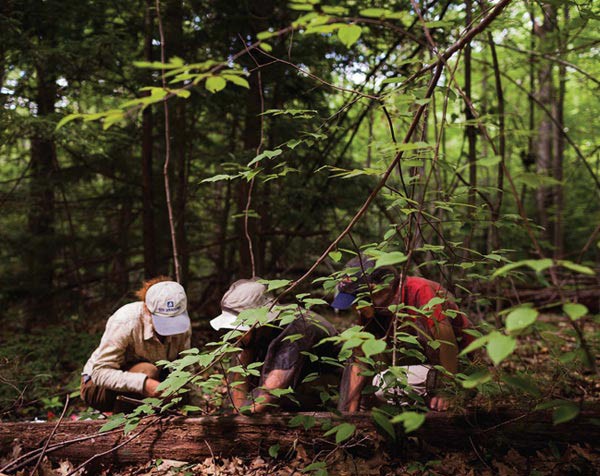
When a stand of trees is blown down in a storm, the typical practice is to salvage as many saleable trees as possible. But a 20- year study in the Harvard Forest found that if you are just considering the health of the forest ecosystem, the best practice is to do nothing.
“When a forest is damaged by hurricane winds, even if it is quite a big disturbance and looks catastrophic, there are a lot of surviving structures that allow the forest to come back and continue functioning,” said Audrey Barker-Plotkin, site and research coordinator at Harvard Forest and lead author of a study published in the journal Ecology.
In 1990, a team of scientists recreated the effects of the 1938 hurricane in a two acre patch of mature oak forest. Eighty percent of the trees were pulled over with a winch and cable; half the trees died within three years and were left on the ground. The scientists closely monitored the study area for the next 20 years and found a remarkable story of recovery.
“Leaving a damaged forest intact means the original conditions return more readily,” said David Foster, director of the Harvard Forest. “Forests have been recovering from natural processes like windstorms, fire, and ice for millions of years. What appears to us as devastation is actually, to a forest, a quite natural and important state of affairs.”
The abundance of seedlings and saplings that were growing in the forest prior to the study form the bulk of the forest canopy today. But the new forest doesn’t look exactly like the old one. Prior to the study, the forest was dominated by red oak and red maple. “We found no red oak that came in as a seedling or sprout after the disturbance, but we have a few scattered surviving gigantic oaks that still anchor the stand,” said Barker-Plotkin. “The new cohort is mostly black birch.”
The researchers were surprised that only a few early successional species made an appearance as the forest recovered, and even fewer invasive species. Most of the shrubs that became established in the first years after the disturbance died as the forest aged.
Measurements of soil nutrient levels before and after the disturbance found hardly any difference, and the volume of litterfall – a reasonable proxy for forest productivity – came back to predisturbance levels by year six. While the basal area is still lagging behind that of a control site, it is expected to catch up by about year 30.
Despite these results, Barker-Plotkin said there are perfectly good reasons to do salvage logging. “If you’re growing your forest for timber and your valuable timber trees have fallen over, it’s a reasonable course of action to carefully recoup the financial value of the forest. But from the perspective of the health of the forest, it doesn’t need us to clean up after a disaster like this. The forest is going to be fine.”

